Can You Do the Navy SEAL Workout?
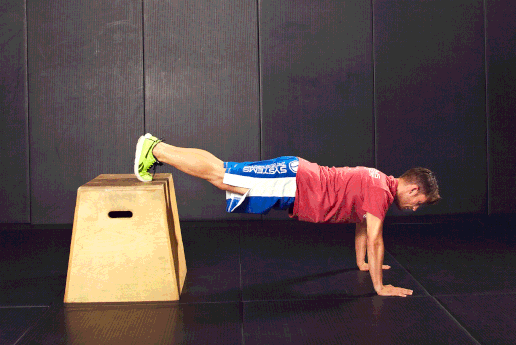
The Ultimate Navy SEAL Workout (Photos: Travis McCoy/travismccoy.com)
Navy SEALs are some of the toughest and most highly trained men in the American military. Because they conduct dangerous missions both in the water and on land and often under the cover of darkness, the skills and requirements to become a SEAL are much more rigorous than any other branch of the Armed Forces.
Candidates must be able to swim long distances, tread water while carrying extra weight, be active in both open water and on the sand and carry around heavy things like boats, says Wes Kennedy, former Canadian Special Forces Operator and owner of Elite Training programs, who has trained Navy SEAL and other special operations candidates. “They need to focus on strength and structural balance, both left-to-right-side balance and front to back,” he says. “The stronger they can be, the better they can express their energy systems.”
Think you can measure up? Here are 10 exercises to incorporate into your workout to build the strength and skills necessary – as well as an outline of the fitness test all SEALs are required to pass.
1. Decline Push-Ups
In order for push-ups to count during the physical screening test, they “must be performed with a straight back and feet and hands in contact with the deck at all times,” according to the SEALs website. “No slouching allowed; proper form must be strictly maintained.”
Related: Build the Best Strength-Training Workout for YOU
HOW TO DO IT: This is another standard exercise pulled from the physical screening exam, but with the additional challenge of performing them while angled toward the floor. So start this variation with your feet elevated on a step or bench and run through the standard range of motion, keeping your body in a straight line from head to toe.
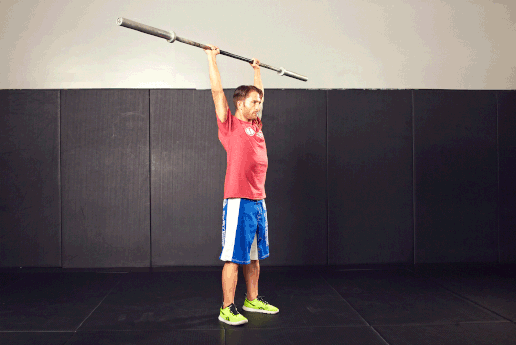
2. Standing Barbell Shoulder Press
Vertical movements are an important part of any SEAL candidate’s training because they mimic functional movements like raising a boat over your head, says Kennedy. He recommends the standing shoulder press to get the full benefits of the pressing motion, including shoulder strength and stability.
HOW TO DO IT: Start standing tall with proper posture while holding a weighted barbell at chest level, hands slightly wider than shoulder-width apart and palms facing out. Raise the barbell straight overhead so that your hands are over your shoulders. Lower the barbell back down to shoulder level and repeat, keeping your core engaged.
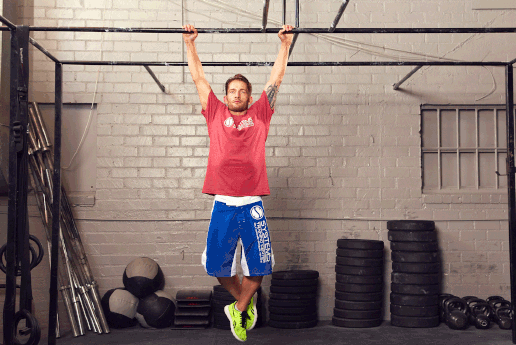
3. Pull-Ups
Pull-ups are an essential part of the SEAL physical screening test (and a very iconic SEAL exercise) because they require a lot of vertical pulling. Kennedy often has special ops candidates perform weighted pull-ups in descending reps from five to two, but starting without weights is plenty of a challenge for non-elites.
HOW TO DO IT: Grab the pull-up bar with palms facing away from you and hands shoulder-width apart. Contract the muscles in your upper back and lift yourself up until your chin is all the way over the bar, then lower yourself all the way back down. Be aware that for the physical screening test candidates aren’t allowed to swing, kick or bicycle their legs to help them up over the bar.
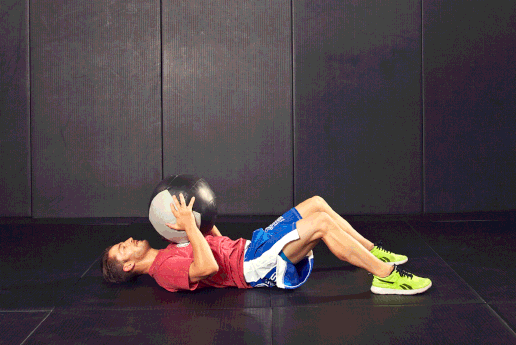
4. Medicine Ball Sit-Ups
Sit-ups are definitely a part of the physical screening test, but these are amped up sit-ups, so if you can do these for two minutes straight, the test should be easier. Plus, sit-ups build abdominal strength, which aid in nearly everything you do.
HOW TO DO IT: According to the Navy SEAL’s site for the physical screening test, proper form is “[sitting] on the floor with your knees bent approximately 90 degrees. Cross your arms in front of you with fingertips touching your shoulders.” Maintain this form while holding a medicine ball in front of your chest as you move through the range of motion.
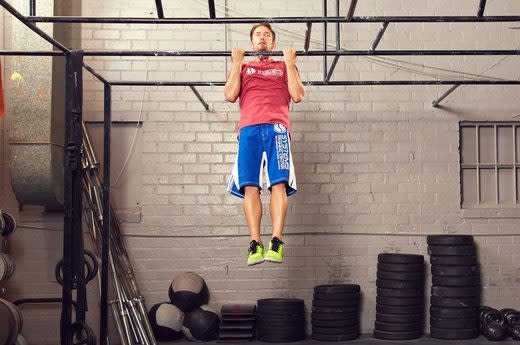
5. Flexed Arm Hang
Your upper-body program can’t rely on pull-ups alone, so this partial variation will build upper-body strength while helping you with the range of motion and feel of doing pull-ups.
HOW TO DO IT: Either pull yourself up so that your chin is over the bar or jump up. Once your chin is over the bar, hold yourself up for as long as you can while still being able to lower yourself back down with control afterward. Since you’re fatiguing your muscles quickly, only do a few reps of these in each workout.

6. Dumbbell Reverse Lunges
“In order to achieve structural balance, you need to do single-leg work,” says Kennedy. Reverse lunges not only require varying amounts of strength and range of motion from each leg, but also challenge your proprioception and core stability. They also help address structural imbalances that may exist in your front-to-back motions.
HOW TO DO IT: Stand while holding a dumbbell in each hand. Without turning your head to look behind you, step back with your right leg and bend both knees to 90-degree angles. Your front knee should stay behind your front toes, and your back knee should stay lifted off the ground. Push off your back leg and return to standing.
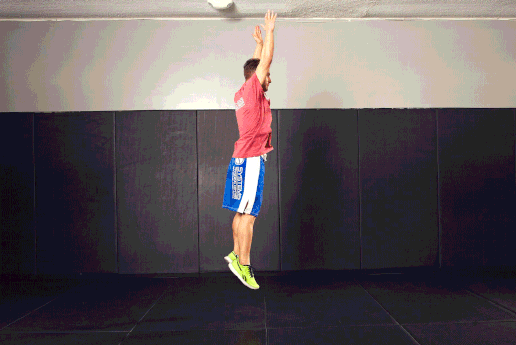
7. Burpees
“Two things are really vital for SEALs: Be really strong and able handle a lot of volume,” says Kennedy. “They put in a lot of work over a long period of time.” One of the best (and most dreaded) ways of taxing both your endurance and strength is by doing burpees. Start out with the standard variation, and then incorporate variations like a burpee with a broad jump or pull-up at the end.
Related: 4 Proven Ways to Beat a Weight-Loss Plateau
HOW TO DO IT: Stand with your hands at your sides before dropping your hands to either side of your feet. Jump your feet out into a plank and descend into a push-up. Push back up and jump your feet back between your hands. From the squatting position, jump up as high as you can. Land with soft knees and go directly into the next rep.

8. Step-Ups
Since single-leg work is vital for eliminating strength imbalances, step-ups help address those between your right and left side and between your front and back. Kennedy recommends candidates close to selection increase their metabolic rate through higher reps and a slower tempo.
HOW TO DO IT: Stand in front of a step or box that is hip-height (or lower if you are just starting out). The more hip flexibility and leg strength you have, the higher your box can be. Place your right foot on the box and step up so that your left foot taps the top of the box. Step down and repeat on the same leg, doing all reps on one leg before moving on to the other.
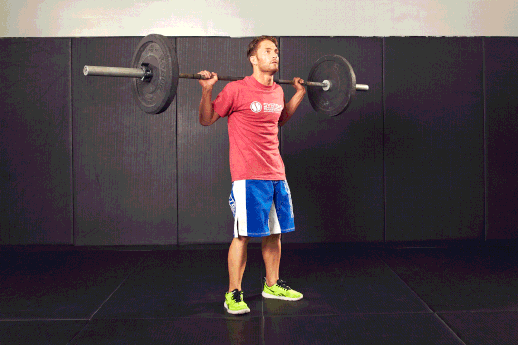
9. Barbell Back Squat
No matter what other exercises your workout features, squats are always a must for building lower-body strength. One of the easiest ways to add weight is with a barbell back squat.
HOW TO DO IT: Load a barbell and hold it across the back of your shoulders. Stand with feet hip-width apart and pointing out slightly. With control, hinge your hips back and bend your knees as if you were about to sit down in a chair. Do not let your lower back sway or arch because that puts you at a high risk for injury. Once your thighs are parallel to the floor, engage your glutes, press through your heels, reverse the motion and stand back up. “Make sure you’re driving through your heels on the glute thrusts,” Kennedy says. “It will take a while for you to learn how to engage the glutes properly.”

10. Dumbbell Farmer’s Carry
A SEAL’s goal should be more than just passing the fitness test, so Kennedy recommends exercises like the farmer’s carry because it mimics real-world situations that require reflexive stabilization (i.e., your body’s ability to stabilize a load while moving). It not only increases your work capacity for ruck marches, but can also help keep you from getting injured.
HOW TO DO IT: Select a fairly heavy dumbbell or kettlebell that you can still safely carry in one hand without leaning to one side. While holding the weight in one hand at your side, walk forward at a normal walking pace, using your core to stabilize the weight as you move. Walk from one side of the room to the other, turn around and come back.
Navy SEAL Physical Screening Test
Want to see if you’re physically fit enough to be a SEAL? Here’s the test all SEALs must pass in order to be considered for this elite branch of service:
1. Swim 500 yards using either a sidestroke or the breaststroke. Goal time: 12 minutes and 30 seconds (competitive times are closer to 10 minutes and 30 seconds).
2. Rest 10 minutes.
3. Military push-ups for two minutes. Goal: 42 to 79 push-ups.
4. Rest two minutes.
5. Full sit-ups for two minutes. Goal: 50 to 79 sit-ups.
6. Rest two minutes.
7. Do at least six unbroken pull-ups with no time limit, but you’ll want to aim closer to 11 to be considered competitive.
8. Rest 10 minutes.
9. Run 1.5 miles. Goal time: 11 minutes (10 minutes and 20 seconds for a competitive time).
The original article “The Ultimate Navy SEAL Workout“ appeared on LIVESTRONG.COM.
By Rachel Grice
More from LIVESTRONG.COM:
10 Yoga Poses to Help You Recover From Your Workout
20 Essential Checks to Help You Run Faster
Is Your Scale Sabotaging Your Weight Loss?

